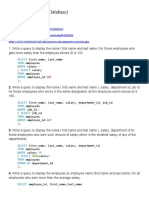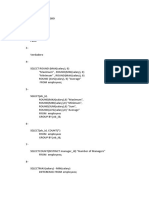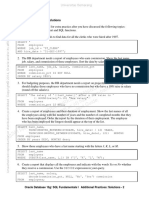0 ratings0% found this document useful (0 votes)
2 viewsSQL Queries
The document contains a series of SQL queries that retrieve and manipulate employee and project data from a database. Key operations include selecting employee details by department, calculating average salaries, updating salaries in the HR department, and categorizing employees by tenure. Additionally, it identifies duplicate entries in the Employee_Projects table.
Uploaded by
vanidhote123Copyright
© © All Rights Reserved
Available Formats
Download as TXT, PDF, TXT or read online on Scribd
0 ratings0% found this document useful (0 votes)
2 viewsSQL Queries
The document contains a series of SQL queries that retrieve and manipulate employee and project data from a database. Key operations include selecting employee details by department, calculating average salaries, updating salaries in the HR department, and categorizing employees by tenure. Additionally, it identifies duplicate entries in the Employee_Projects table.
Uploaded by
vanidhote123Copyright
© © All Rights Reserved
Available Formats
Download as TXT, PDF, TXT or read online on Scribd
You are on page 1/ 2
Q1: Retrieve the first_name, last_name, and department_name for all employees,
ordered by department_name.
SELECT e.first_name, e.last_name, d.department_name
FROM Employees e
JOIN Departments d ON e.department_id = d.department_id
ORDER BY d.department_name;
Q2: Find the names of all projects in the 'IT' department
SELECT p.project_name
FROM Projects p
JOIN Employee_Projects ep ON p.project_id = ep.project_id
JOIN Employees e ON ep.employee_id = e.employee_id
JOIN Departments d ON e.department_id = d.department_id
WHERE d.department_name = 'IT';
Q3: Find the average salary of employees in each department
SELECT d.department_name, AVG(e.salary) AS average_salary
FROM Employees e
JOIN Departments d ON e.department_id = d.department_id
GROUP BY d.department_name;
Q4: Find the top 3 highest-paid employees in each department.
SELECT first_name, last_name, department_name, salary
FROM (
SELECT e.first_name, e.last_name, d.department_name, e.salary,
RANK() OVER (PARTITION BY e.department_id ORDER BY e.salary DESC) AS
rank1
FROM Employees e
JOIN Departments d ON e.department_id = d.department_id
) ranked
WHERE rank1 = 3;
Q5: Increase the salary of all employees in the 'HR' department by 10%
UPDATE Employees
SET salary = salary * 1.10
WHERE department_id = (SELECT department_id FROM Departments WHERE department_name
= 'HR');
Q6: Find all employees whose salary is higher than the average salary of all
employees in the company.
SELECT first_name, last_name, salary
FROM Employees
WHERE salary > (SELECT AVG(salary) FROM Employees);
Q7: Categorize employees based on their tenure (Senior, Mid-Level, Junior).
SELECT first_name, last_name, hire_date,
CASE
WHEN TIMESTAMPDIFF(YEAR, hire_date, CURDATE()) > 5 THEN 'Senior'
WHEN TIMESTAMPDIFF(YEAR, hire_date, CURDATE()) BETWEEN 2 AND 5 THEN
'Mid-Level'
ELSE 'Junior'
END AS employee_category
FROM Employees;
Q8: Identify any duplicate entries in the Employee_Projects table.
SELECT employee_id, project_id, COUNT(*)
FROM Employee_Projects
GROUP BY employee_id, project_id
HAVING COUNT(*) > 1;
You might also like
- SQL Project ScienceQtech Employee Performance Mapping...No ratings yetSQL Project ScienceQtech Employee Performance Mapping...14 pages
- Complex SQL Interview Questions - Part 2No ratings yetComplex SQL Interview Questions - Part 211 pages
- all quries of selected labs with skip topicsNo ratings yetall quries of selected labs with skip topics3 pages
- allllllll quries of selected labs with skip topicsNo ratings yetallllllll quries of selected labs with skip topics5 pages
- Rdbms and SQL: Name:Ibrahim Sameer V S REG NO:17BCA0062100% (1)Rdbms and SQL: Name:Ibrahim Sameer V S REG NO:17BCA006233 pages
- Select Employees - Id, Last - Name, Sal 12 "Annual - Salary", From EmployeesNo ratings yetSelect Employees - Id, Last - Name, Sal 12 "Annual - Salary", From Employees9 pages
- Jawaban Tugas Akhir Dasar SQL: NVL Dan JOIN: Amelia Shabrina 6701140139 PIS-14-06No ratings yetJawaban Tugas Akhir Dasar SQL: NVL Dan JOIN: Amelia Shabrina 6701140139 PIS-14-062 pages
- FYMCA53 - Experiential Learning - SolutionNo ratings yetFYMCA53 - Experiential Learning - Solution8 pages
- Get All Instructors Names Without RepetitionNo ratings yetGet All Instructors Names Without Repetition7 pages































































